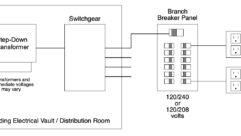NEVER ASSUME anything about the wiring of power outlets
Aug 1, 2000 12:00 PM,
Bill Whitlock
You have probably heard the saying that to assume makes an ass of you andme. When trying to track down and correct A-V system noise or interferenceproblems, false assumptions can lead to plenty of wasted time andfrustration. One assumption that is all too easy to make is that poweroutlets are wired correctly. Ken Fause, a colleague with extensiveexperience designing A-V systems for large theatrical and stadium venues,says that it is common to find 20% of outlets wired improperly in olderbuildings.
Partly because of the existence of low-cost outlet testers, the percentageis much lower in newer construction. Although these simple $10 outlettesters will find such dangerous problems as hot-neutral or hot-groundreversals, they cannot detect a neutral-ground reversal. This insidiouswiring error, shown in Figure 1, can create nightmarish symptoms in anaudio or video system.
In a correctly wired power system, all load current flows in the hot (orphase) and neutral wires. The safety ground wiring normally carries onlysmall leakage currents from devices on the branch circuit having grounding(three-prong) plugs. This current is generally only a few milliamperes atmost. Because of normal resistance in the ground wiring, small voltagedifferences will exist between the grounds of any two outlets on the branchcircuit. Remember that these voltage differences, even though they are onlya few millivolts, will be impressed across signal cables that connectequipment plugged into these outlets. For systems with two or more piecesof equipment with grounding power plugs, connected by unbalanced signalcables such as coax video or RCA audio, even this tiny voltage cansometimes cause hum problems.
Note that when an outlet is improperly wired as in Figure 1, the loadcurrent for any device plugged into it flows in the ground conductor.Depending on the device, this current could be up to 10 amperes or 15amperes. Again, because of normal resistance in the ground wiring, voltagedifferences will be created between outlet ground pins, but in this case,they can be a high as a volt or two. This would virtually guarantee humbars in a video display if it were grounded to one of these outlets and itsvideo source were grounded to another. This is in spite of following thegenerally recommended practice of powering all system equipment from asingle branch circuit whenever possible.
Although there are certainly procedures involving current probes oninternal distribution panel/breaker box wiring and test loads on branchcircuits (to be performed only by qualified personnel), which would revealsuch mis-wiring, probably the simplest procedure is to inspect thesuspected outlet for correct wiring visually with the power off, of course.
In the United States, standard 120 V outlets may be grounded in two ways.In the first, metallic junction boxes and conduit serve as the groundconductor. When a standard saddle-grounded outlet (mounting tabselectrically tied to the ground socket) is mounted to the metallic box, theground connection is made. It is nearly impossible for this style of wiringto suffer from a neutral-ground reversal. The second method uses a wire,either green, green-yellow or bare, as the ground conductor. This wire isconnected to a terminal (generally colored green or marked “ground”) on thereceptacle, which may also connect to its metallic mounting saddle. Thismethod may use either metallic or plastic junction boxes.
Another assumption that can lead to trouble is that devices that aresupposed to be grounded, even those required by regulatory codes, reallyare. This should include metallic water pipes and building entry points fortelephone and cable television services. We rely on these connections forsafety, but they are made by installers who are often, to be charitable, ina hurry and do less than professional work. I recently moved, and in theprocess of tracking down some telephone wire problems (that is anotherstory), I removed some wallboard in the garage. I was delighted that power,telephone and cable TV lines entered within inches of the earth ground rod(just behind the large conduit at the right in Figure 2). This is the idealsituation for safety grounding. A closer inspection, however, revealed thatthe large green grounding wire from the cable television box (at the upperleft corner of Figure 2 on the outside of the wall) did not connect toground (or anything) at all. It had simply been pushed into the wall andleft there. I have since corrected this and made all the wiringconsiderably neater, too.
Such a floating ground on a cable television feed can result in severalvolts of ground noise being delivered via the shield and/or splitters to TVand VCR system components. The circulating ground current often causes humand buzz problems throughout an A-V system. It is a good idea to check forvoltage between the shield of a cable TV feed and the ground of a nearbypower outlet. If it is more than about a tenth of a volt, check out theground where the CATV feeder enters the building. Remember, it is wisenever to assume anything, especially when it comes to tracking down A-Vsystem noise.










